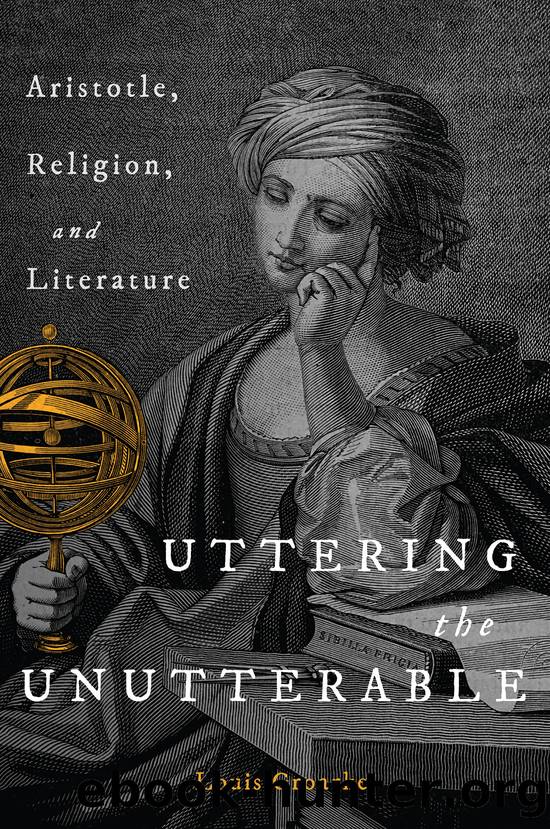Uttering the Unutterable by Louis F. Groarke

Author:Louis F. Groarke
Language: eng
Format: epub
Publisher: McGill-Queen's University Press
Published: 2022-11-22T00:00:00+00:00
5
Definition by Four Causes
V.1 ARISTOTLEâS THEORY OF FOUR CAUSES
I will now elaborate four separate but overlapping definitions of Âliterature using Aristotleâs theory of four causes. Consider, first, how Aristotle uses his theory of four causes to explain the nature of the world.
In an Aristotelian cosmos, properties are instantiated in individual substances, which can be explained in terms of (1) material cause: the physical substrate; (2) formal cause: the characteristic pattern or structure; (3) efficient or moving cause that causes the thing to exist, and (4) final cause: the purpose or goal (ÏÎλοÏ, telos).1 Simply put, we can describe things from the perspective of matter, form, change, and purpose. These causes are closely related, but Aristotle never tries to reduce them to one.2 He observes that formal, efficient, and final causes âoften coincide,â3 but this is a comment on overlapping explanations, not a recommendation that we conflate these explanatory perspectives. (Note that the Greek words Aristotle uses for cause â âαἴÏιον,â âαἰÏίαâ [cause or reason] â could be translated as âexplanation.â We could refer to âAristotleâs four causesâ or to âAristotleâs four explanationsâ without any real difference in meaning.)
Living things make up the most important Aristotelian class of substances. Organisms have a material and a formal cause, a body and a soul. They serve, mostly, as their own efficient cause (they reproduce themselves) and their own final cause (their purpose is the survival of the species). Artifacts, say machines, also have a material, formal, efficient, and final cause: in order, the physical stuff they are composed of, how they are designed, the craftspeople who make and repair them, and the purpose they serve. There is inevitable scholarly disagreement about details, some of which we discuss below. But this is the basic picture.
Although Aristotle has a healthy respect for material and efficient cause, he is not a modern-day reductionist. In a passage that sounds almost Neoplatonic, he writes: âIt is not likely that either fire or earth or any such element should be the reason why things manifest goodness and beauty both in their being and their coming to be ⦠nor again could it be right to ascribe so great a matter as beauty and goodness to spontaneity and luck.â4 Aristotle maintains that we cannot account for goodness and beauty exclusively in terms of material cause (the elements) or random chance (the absence of final cause). Because he situates teleology â striving to achieve a goal â within biological and even inanimate natures, we can have âscientificâ explanations that refer to goodness and beauty understood in terms of the fulfilment of a nature. There is no is/ought gap in Aristotle as in modern philosophy. This opens up room for thoroughly normative sorts of investigation.
We can use the four causes to explain almost anything. Consider a rattlesnake. What is the material cause? The DNA, the carbon molecules, the tissues, the bones (etc.) of which it is composed. The formal cause? The species to which it belongs: rattlesnake (with all that entails). The efficient cause? Reproduction and a steady supply of food.
Download
This site does not store any files on its server. We only index and link to content provided by other sites. Please contact the content providers to delete copyright contents if any and email us, we'll remove relevant links or contents immediately.
The remains of the day by Kazuo Ishiguro(8818)
Tools of Titans by Timothy Ferriss(8215)
Giovanni's Room by James Baldwin(7189)
The Black Swan by Nassim Nicholas Taleb(7010)
Inner Engineering: A Yogi's Guide to Joy by Sadhguru(6724)
The Way of Zen by Alan W. Watts(6504)
Asking the Right Questions: A Guide to Critical Thinking by M. Neil Browne & Stuart M. Keeley(5631)
The Power of Now: A Guide to Spiritual Enlightenment by Eckhart Tolle(5604)
The Six Wives Of Henry VIII (WOMEN IN HISTORY) by Fraser Antonia(5394)
Astrophysics for People in a Hurry by Neil DeGrasse Tyson(5130)
Housekeeping by Marilynne Robinson(4336)
12 Rules for Life by Jordan B. Peterson(4249)
Double Down (Diary of a Wimpy Kid Book 11) by Jeff Kinney(4205)
The Ethical Slut by Janet W. Hardy(4172)
Skin in the Game by Nassim Nicholas Taleb(4161)
Ikigai by Héctor García & Francesc Miralles(4124)
The Art of Happiness by The Dalai Lama(4063)
Skin in the Game: Hidden Asymmetries in Daily Life by Nassim Nicholas Taleb(3929)
Walking by Henry David Thoreau(3892)
